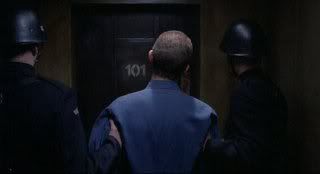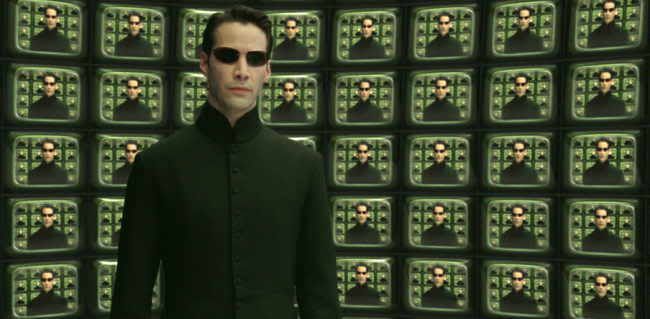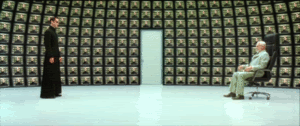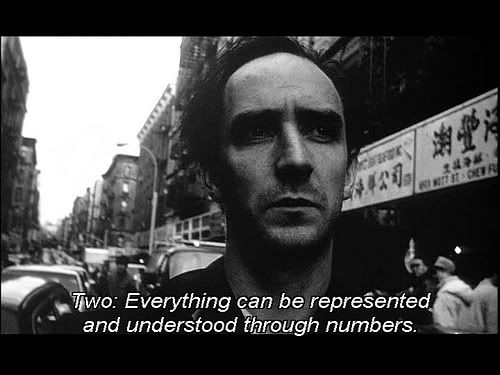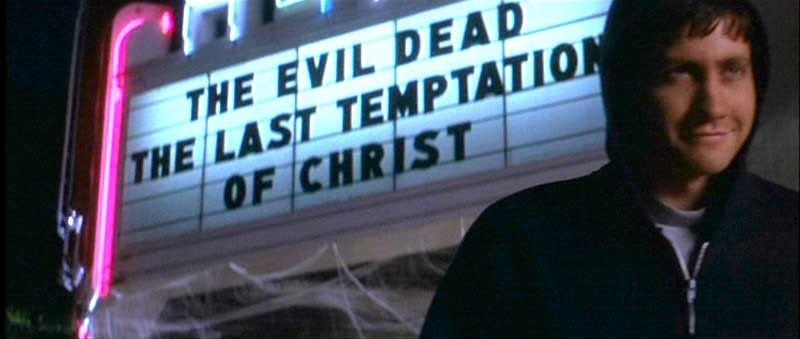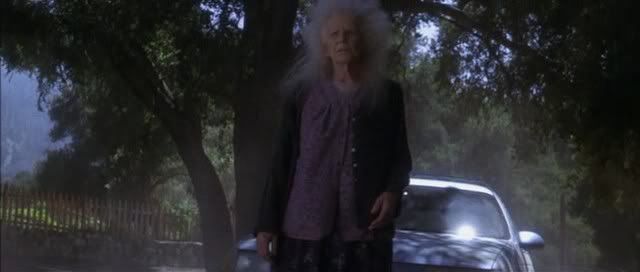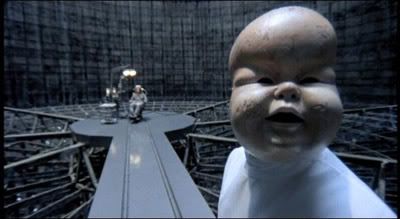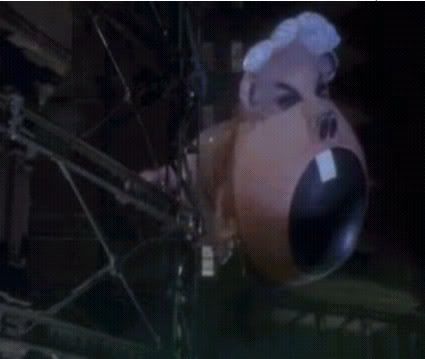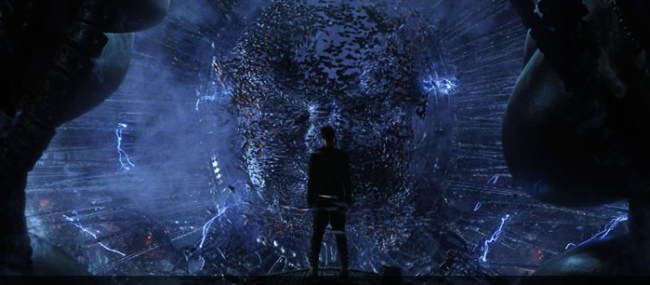
This is the last post in this series after, Nigredo, Albedo, and Cauda Pavonis. The name "Rubedo" refers to the last phase of the alchemical process when the Stone is finally achieved. You do not have to read the first three parts to enjoy this (well, I hope you enjoy it!), but you might want to go back and check them out if you haven't already, just to get a better picture of the whole movie. At the closing of the last scene, where the effigies are burned, Jodorowsky also burns his style of filming and returns to a simpler style he refers to as more real, and as reality. Though he's concentrating more on the style of the film, it also serves as foreshadowing of a return to reality for the characters who are leaving the illusionary world of money and power behind. The next scene has the group walking through beautiful green mountains, far removed from the factories we have seen these characters inhabit previously. The Prostitute and chimp are still following The Thief. There's some interesting tidbits in the commentary, so I'll be throwing a lot of that in this final part of this series of articles.
The first stop for the group of characters, who I have explained previously are each represented by the actor who closely resembles his or her character in real life, is a dwelling of an actual shaman playing himself on screen just as the actors. The location it's filmed in is the Tepoztlan area which is said to have been the Mexican Eden, where the gods lived; an analogue to The Holy Mountain they are journeying towards perhaps. Jodorowsky didn't direct the shamans, they just did as they pleased and he filmed it. This shaman does actual techniques he would do in real life such as "cupping" which I know is also used in acupuncture.
One of the group members is sickened by the smell of the old man, so The Alchemist breaks all his bones and says he'll like the shaman's smell when he gets done fixing him! "If you hate a person, you hate something in him that is part of yourself. What isn't part of ourselves doesn't disturb us." - Hermann Hesse. The guy who hates the Indian shaman really hates the knowledge that he is the same aging flesh-bag as the shaman and everyone else, and he hasn't yet come to terms with that. I hate stupid people because I know I was one of them and still am in other ways, I'm sure. So, I really hate that capacity in myself which could turn me into a zombie at any moment. Other people are mirrors for our selves. we gauge our appearance by the looks in their faces. Even animals can serve this purpose which I see everyday because my sister hates her dog which is exactly like her in every way; a doggie-mirror of all her anxieties. It's funny, but also sad that we can dispense so much negative emotion on others because we hate parts of ourselves. Of course, what you do to others, you do to yourself; thoughts have forms, emotions and words affect the world around us. The time in my life when I really, really, hated other people coincided with the time when I really hated myself.
Jodorowsky has been unusually lucky to come in contact with many Masters in his life, mostly female, and during the filming on the mountains, he just decided to go up and film at the top of a mountain saying "We'll find a master there," and he was right. He found female shaman waiting who said "I've come to help you." It would seem that some intelligence conspired to give authenticity to this movie, and it's too bad it was kept underground for so long, but now it's finally out there affecting the global consciousness.
Another shaman greets the group in real life on another mountain. "The flower knows. You don't need to ask it." (The flow-er knows) Here the group runs through a field of flowers to gather pollen on their bodies. They are getting close physical contact with nature, here, and at the last shaman who gave them a soup made of some plants. The pollen represents the hallucinogenic plant world, and it is gathered from the bodies, rolled into a ball, and placed into a cut on their bellies. Jodorowsky goes on the explain that the actors themselves stayed locked up in a house for two months with only 4 hours of sleep doing all kinds of exercises as well as hallucinogenic mushrooms. Needless to say, there must have been some profound psychological change in these actors at the time. I have heard of other cases of monks being locked in the dark until they can produce their own light, or sitting in the snow until they can produce their own heat, or spending weeks in the dark on special diets while their pineal gland is being stimulated to open their third eyes. A severe retreat from the world is sometimes necessary to erase the ingrained programming of the illusionary world. I recommend people do some traveling to other parts of the world, not because you're going to find something there you couldn't have at home (like going to India to find enlightenment which never works), but that by doing so you gain some perspective and can see that there's more to the world, more ways of thinking, living, and so on.
Anyways, the pollen causes them to "shapeshift" or transfer their consciousness into the surrounding animals, and to see the world through their senses. A dog(/god) walks by and they smell the flowers through it's nose. Then, they get up and walked in a chain holding hands and say "Together we form a dog in search of a sacred flower." Then they are laying down with their legs up, first together then spreading apart, and say: "Together we form a flower in search of a sacred water." Voice over: "This is the moment when the Word is made flesh." This scene is a synchromystic's dream these days, but I'll just say that together they do form a god/dog in search of a sacred flower. The on-line etymology dictionary says "sacred" may connect to words which mean to "bind, restrict, enclose, protect," which seems to fit. The sacred flower is the hidden flow-er, off limits to Man, that is The Godhead. The fountain-head of consciousness, or simply The Fountain.
They are a "god"(dog), I say, because that's all it takes to create one – a large enough group of believers. I think it takes at least 10 people to be recognized as an official religion. There was a experiment in contacting a soul through a séance which was successfully carried out and information was obtained which matched perfectly the history of this particular soul. The cosmic rub is that the soul was a fictional creation by the original team, given a name and back-story, and then contacted through the séance. Over time they removed the original group members who knew the truth and replaced them with people who didn't until they had mostly or all new members of the group channeling a non-existent soul! I don't remember the details, except that it made me feel that this is the basis for religion and miracles. A group such as the 10 characters in The Holy Mountain, or the 10 people starting a religion, are collectively their own God, "This is the moment when the Word is made flesh." Yet, like all religions, they search for the sacred flower, or rather the hidden original Flow-er (to beat a synchromystic horse to death).
The group then sits with the shaman and he asks how many are in their group. A couple of them count the group of ten, but only come up with nine each time. The shaman directs them to look into a reflective bowl of water. Each looks and and says "Here's the missing one, they drowned!" They are now at a stage in their evolution where they have forgotten their self, and are open to find the true Self. This reminds me of the movie Bulletproof Monk, where the monk has to forget his own name. They go on a funeral march and bury the "missing person" (the self) in a hole and cover it with dirt.

This is continued at a Mayan pyramid where they have a death ceremony where they cover each other in dirt as if they were being buried. The Alchemist: "The grave receives you with love. Surrender yourself to the earth. Return what was loaned to you." He continues on giving up their past, including friends, lovers, family, desires, hates, etc. The actors are actually crying about their death at this point, Jodorowsky makes the point that they're not acting in this scene, but are really sad. He filmed the movie chronologically so that the actors would change along with the characters they play.
The Alchemist: "You have a grave, it is your first mother. The grave is the door to your rebirth. Now you will surrender the fateful animal you once called your body. Don't try to keep it. Remember, it was a loan."
When the goddess enters the Underworld, she has to give up an article of clothing, a possession, at each of the nine gates until she is naked. When we enter this world through the spectrum of colors, chakras, planets, etc, we get a piece of each, and this can be seen in your zodiac natal chart which shows where the planets were when you were born. People born under certain signs are statistically more likely to get certain diseases, disorders, or have certain health issues according to their sign. In Alchemy circles, it is believed that you receive certain cell salts for each sign/month of gestation, and everyone is lacking 2 or 3 salts when they are born because they obviously didn't gestate for an entire year. And by taking these salts you can fix certain health problems which a person born under your sign is more likely to have. (See this PDF file for more. Mine says, "light sensitivity," which is funny because I put on sunglasses colored over with black marker when I wake up because I hate the brightness!) So, there do seem to be certain qualities we each have from birth, and these are given back to the planets as we strip away our earthly identity on our way back to the source.
The Alchemist and The Planets and The Thief are all about to board a boat when The Thief is mobbed by a group of kids and attempts to feed them all with his bread (staying true to his earlier Jesus persona). The Alchemist laughs and shows The Thief a vision of what would happen if he performed this miracle. He sees the kids attack each other as they each try to hoard as many bread loaves for themselves.
"In America, first you get the sugar, then you get the power, then you get the women." - Homer Simpson.
In the movie The Invention of Lying, nobody in the world can tell a lie, except one man. He uses his gift in an attempt to help people (after using it for gain for himself), and he only makes things worse in the long run. If not worse, then at least not an improvement. A better example might be Bruce Almighty. The point is that a imperfect person, still acting from the self and not the Self, will only produce imperfect things or effects in the world. It reminds me of the Lancet-Percey stock-picking company advertisement in Pi which says "86% Accurate, only god is perfect." I feel the same way about the current trend towards a revolution against the current state of the world. The only true "Revolution" will be R/Our-evolution. If you can't fix things in your own life, how can you do it on a much larger scale?

On the boat, The Alchemist pulls geometric shapes away from his head and says, "Our thoughts have forms." And he points to The Thief and says, "You have a monster in your mind." The group pulls him in and out pops The Dwarf. But since he is the licentious devil on The Thief's shoulder, so to speak, only The Thief can see The Dwarf. He must toss him overboard and remove this tumor from his soul. The Alchemist: "Free yourself from the past." The chimp with The Prostitute is like the dwarf and The Thief, it's her own companion which she must someday get rid of. On the subject of thoughts having forms, some of you may have seen the movie What The Bleep Do We Know? or otherwise have heard of perfectly named Dr. Emoto and his "Messages From Water" research and book. Basically, our thoughts have an affect on water, and this is important when considering how much water is in each of us, and the world around us. See this article at Red Ice for more.
Prayer and the co-creation of reality, at The Dawn of Aquarius blog: (Thought + Emotion) + Action = Result
"Therefore I tell you, whatever you ask in prayer, believe that you have received it, and it will be yours. " - Mark 11:24
The group has finally made it to Lotus Island. Upon arrival they all cut their hair; perhaps because it represents all the days of their past, but also its a traditional form of cleansing. The are greeted by a jolly fellow drinking a massive glass of wine or champagne who welcomes them to Lotus Island with a basket of food. The basket actually reminds me of the scene in A Clockwork Orange where Alex de Large is in the hospital and he is given a basket of fruit with something inside which appears to say "EAT ME" like the food in Wonderland which Alice comes upon. There's the babe in the basket myths, but I'm thinking about Jesus and his "EAT ME, DRINK ME" advice to his disciples. Doing so grants eternal life, but as I've pointed out, it does the same thing for vampires and zombies. These are beings who want a material immortality because they don't want to leave something behind (like shopping malls for instance, which is seen in Dawn of the Dead).

We learn that he runs a bar on the island where everyone goes when they first get there which is called the Pantheon Bar. Next to the bar is a sculpture meant to represent "The Thinker" by Rodin. Jodorowsky says it represents the flaws of intellectualism.
"Your knowledge of many things does not grant you wisdom." - Heraclitus (ca. 540 - ca. 480 BC)
"On the path to discovery, the intellect has little to do. There is a leap in consciousness, call it intuition or whatever you like, and the solution comes to you, and you do not know how and why." - Albert Einstein
In I, Robot, Sonny the robot draws his dream of a large group of robots who he says are "slaves to logic." The logical must be mediated by the emotional, the two halves of a complete person. It's your internal Mr. Spock to your internal Captain Kirk. Or more pointedly, your internal antagonist versus your internal protagonist, which is what is being played out in most movies which follow this basic structure. This can be seen in Star Wars where your light and dark sides fight each-other, and in Austin Powers (part 3), Dr. Evil tells Austin Powers, "We're not so different, you and I." (Both characters being played by the same actor – *hint hint*) He joins with Austin Powers at the end. It's like Darth Vader with Luke. When Luke kills his internal Darth Vader in the cave on Degobah while training with Yoda, Yoda calls it a failure. Later, Luke stops short of killing Vader and by doing so causes Vader to join Luke. This is the victory, not just killing the dragon, but drinking it's blood, or transforming the poisonous "waters of life" in Dune into drinking water. Similarly, in the movie Daybreakers vampire blood is poisonous to vampires, but once it has been transformed by the sun it becomes a cure. You don't get rid of your internal Lead, you keep it and that is what you turn into Gold.
"Be careful, lest in casting out your demon you exorcise the best thing in you." - Frederich Nietzsche.
The Ego will violently oppose this however: "The attainment of enlightenment from ego’s point of view is extreme death." - Chogyam Trungpa
The Pantheon Bar gets it's name from the Pantheon temple which was a house for all the gods of ancient Rome. The source of knowledge of many things, "the Wikipedia," states that "the generic term pantheon may be applied to any building in which illustrious dead are honored or buried." The Pantheon Bar is a cemetery where a continuous celebration is always going on. The people at this party are all the previous people to journey to Lotus Island in search of The Holy Mountain. They all got this far, this close to their goal, but stopped at the level of material and temporal success. Maybe that's why it's the Pantheon Bar, as a "bar" blocks the path; it bars the passage. "Hitherto shall thou come, but no further." - Job 38:11

The second wonder to be noted in the Bodhisattva myth is its annihilation of the distinction between life and release-from-life – which is symbolized in the Bodhisattva's renunciation of Nirvana. Briefly, Nirvana means "the Extinguishing of the Threefold fire of Desire, Hostility, and Delusion." [In the] legend of the Temptation under the Bo Tree the antagonist of the Future Buddha was Kama-Mara, literally "Desire-Hostility," or "Love and Death," the magician of Delusion. He was a personification of the Threefold Fire and of the difficulties of the last test, a final threshold guardian to be passed by the universal hero on his supreme adventure to Nirvana. Having subdued within himself to the critical point of the ultimate ember the Threefold Fire, which is the moving power of the universe, the Saviour beheld reflected, as in a mirror all around him, the last projected fantasies of his primitive physical will to live like other human beings – the will to live according to the normal motives of desire and hostility, in a illusory ambient of phenomenal causes, ends, and means. He was assailed by the last fury of the disregarded flesh. And this was the moment on which all depended; for from one coal could arise again the whole conflagration. (The Hero With A Thousand Faces, Joseph Campbell)In The Imaginarium of Doctor Parnassus, the first person through the "looking glass" mirror into the Doc's head eventually makes it to the base of a large mountain of giant steps and a voice from above beckons him to continue upwards to salvation. But, he is distracted by Mr. Nick's Lounge Bar, like the Pantheon Bar, which is where those not destined to summit the Holy Mountain will go to take it easy for a while and just enjoy the material world a bit more (at least one more spin on the wheel of birth-death-rebirth).
The group is led through some mausoleums by the owner of the Pantheon Bar who is hoping to convince them to stay and learn from some of the people there. They are street-corner preacher types who dish out their half-baked knowledge, which is lacking in wisdom. The first is a man in a star-spangled top-hat, inspired by Allen Ginsberg, who says the real Holy Mountain is in his words and poems, but the group sees his words to be shit and not honey like he claims. Jodorosky says that poetry like his can't preach enlightenment, though it could be a step on that path. And this is like the other people they meet here, each one representing a step many have us have probably reached on our personal journey.
Next, they move on to my favorite of these Pantheon Bar attendees, the Drug Master, or Drug Guru as I like to call him. Jodorowsky is poking fun at Tim Leary and that era's enlightenment through LSD ideas. He explains that the Artists journey is very long, and heavy drug use can shorten the time you have to learn. By "Artist" he means Alchemist, as it is the Royal Art, and alchemists are known for not only gold making, but life extension. At some point in the commentary, Jodorowsky tells of an Alchemical legend that there are alchemists walking the earth who are 30,000 years old.

The Drug Guru explains that "The cross was a mushroom, and the mushroom was also the Tree of Good and Evil. The Stone of the Alchemists was LSD. (He pops some pills at this point.) The Book of the Dead was a trip. And the Apocalypse describes a mescaline experience. In these flasks are all the Holy Mountains. And in this beautiful young man... is eternity."
What a great scene. Jodorowsky no doubt came upon the mushroom-as-source-of-biblical-symbolism theories during his obviously extensive research. I will admit there are some elegant alternatives to many origins of symbols, but that's all they are is symbols. The mushroom is like the Tree of Life symbol in the Kabbalah, it's a framework, a mnemonic device which was clothed in other symbols. The problem is getting stuck worshiping the finger and not what it points towards. I just asked for and received the 40th anniversary edition of The Sacred Mushroom and The Cross actually (thank you Satan/Santa). However, I'm only ready to read it because I'm past the stage where "all religions come from drugs" so I'm not going to be preaching like the Drug Guru (Anymore – I did spend some time explaining the religious sources of entheogens and astrotheology to my cousins a while back...). This is just one more stop on the way to true Gnosis, and it can be very tempting to stay at a level like this, which is exactly what is being represented by having the Drug Guru in the Pantheon Bar and not on his way to the Holy Mountain anymore.
The last person they talk to is actually a mountaineer, only he has mastered the ability to travel horizontally through the mountain rather than up it. He represents people who make great efforts, Jodorowsky says, but still fail to "climb the Holy Mountain." He's a burly guy who clearly possesses some rare talent, but that's obviously not getting him any closer to the summit of the mountain. The group leaves the Pantheon Bar after this with their host running after them explaining that he can give them trophies and awards and that by leaving they are throwing that all away. He says they "could have made history," but that's not what they want, to go down in some book as famous wise-guys; instead they continue on to anonymous enlightenment.
The group now continues towards The Holy Mountain and actually does some mountain climbing. The group continues through the snow and the hand of one of them becomes frozen because "he was never able to forget his body." He must sacrifice his fingers to go on.
They have mastered the difficult part of the mountain. Now their minds will decompose and suffer the vision of death. (I'm not sure if I wrote that or if I was quoting Jodorowsky, but whatever, it sounds cool.) I think at this point I'd have to warn against watching this movie while stoned... The Alchemist covers his face with a black veil and walks a tiger. The rest follow holding a chain and have visions of their worst nightmares, some of which are their greatest desires turned against them. One woman gets drowned in sperm from a giant "penis" which is depicted as cows having sex and a fist going into her mouth. One man sees a tree covered in dead roosters/cocks and a scary lady with a sword in the tree who cuts off his "Johnson" and hangs him there on the tree. One guy is covered in tarantulas (this would freak me out!). One is pummeled by gold coins. One guy faces a hermaphroditic old man and drinks from his "moobs" (man boobs) which have become cheetah heads spraying milk.

Angels and Demons can't cross over onto our plane. So, instead we get what I call half-breeds. The influence peddlers. They can only whisper in our ears. But a single word can give you courage, or turn your favorite pleasure into your worst nightmare. (Keanu Reeves in Constantine)The Alchemist, The Planets and The Thief have finally reached the abode of The Immortals. They meditate for three hours before moving up. The Alchemist leaves and tells one of the group that he doesn't need a master anymore, and to decapitate him (The Alchemist). He does so, but The Alchemist tricks him and a lamb is decapitated instead, like in the story of Abraham and Issac.
Before moving on to the Immortals, The Alchemist tells The Thief to leave with The Prostitute who has gone through the same journey while trailing them up the mountain. "Unite yourself with this good woman who came here only because she loves you." The Alchemist gives The Thief his alchemical rooms and charges him with changing the world.

The return of The Thief is similar to many ancient myths decoded by Joseph Campbell in The Hero With A Thousand Faces. The hero may choose to return to his world with the "boon" (the grail, elixir or power he has gained through his journey) and apply it to his world. The Thief is now shown to be like Prometheus, who stole the fire of the gods and brought it down for all Men. The Thief made it to Lotus Island and scaled The Holy Mountain only to come back down and live among people again like The Buddha. Like the changed "waters of life" and the cure for vampirism mentioned earlier in this article, the transformed Thief can serve as a pointer to enlightenment for others.
Jodorowsky says, "There is a part of us that will never reach the Holy Mountain. We seek perfection but even the Buddha has a body. And Christ, despite being God, has a human body. The human body is mortal. We must accept that part of ourselves and set it free in the world. That part must go back to the world. The spiritual, enlightened being, must succeed in the world. He is not a victim and must learn to succeed in the world." He brings up an interesting point, that perfection is not possible in this physical reality, nor is it very desirable. When CD's came out, people hated them because records had that 'warmer sound' to them. When MP3's started getting better, they found that people preferred lower quality MP3's over the higher quality ones, because they sounded more natural. People can't stand pure white light of LED's so they have to add a little bit of red in them. My cousin told me that some movies on BlueRay high-definition DVD's are ruined by the crystal clearness because the makeup and costumes look obviously fake. Supposedly, a more symmetrical face is more attractive, but have you ever seen a fake face on one of those Japanese sex robots, or anywhere else? They look obviously fake and unnatural. Speaking of the Japanese, they pride themselves on their different features because traditionally they all pretty much look the same. Frighteningly crooked teeth and hairy moles are marks of beauty there; and clearly are not representative of perfection. So, I don't believe that anyone can be 100% perfect and immortal here in the physical universe. While alive, we will always have one foot in the material realm, like The Star tarot card which depicts a woman with one foot on land and one in water.

The Holy Mountain, as all holy mountains, is the place where the Heaven and Earth meet. It is the uniting of the two halves of the original creation.
According to another Aztec myth, before the creation of the world, there was only the sea and the Earth Monster, Cipactli, who took the form of a crocodile. Tezcatlipoca tempted Cipactli to the surface of the ocean using his foot as bait. The Earth Monster rose to the surface and devoured Tezcatlipoca's foot but during the struggle she lost her lower jaw and was left too weak to return underwater. Tezcatlipoca and the god Quetzalcoatl joined forces to capture her and created the earth from her carcass and formed the tribes of men from her back.The (usually) male Sky God and the female Earth Matrix which were pushed apart by their children during the creation of the world meet at the Axis Munde, the World Pillar, World Tree, or The Holy Mountain. The earth's axis is where the point on the surface on top points to the North Star, and this is sometimes symbolized by a pillar. I've heard of people being able to peer through the veil by meditating and focusing on this spot in the heavens. The spin of the earth around this point may have caused the creation of the swastika shape (a symbol of luck, as well as creation/destruction depending on the spin) via the Little and Big Bear constellations which can be combined in their spinning to form the familiar shape. The serpent constellation Draco wraps around the pole star. The word cyclone from the Greek word kyklon refers to moving in a circular pattern, and is connected to the idea of the coil of a snake. The cyclone to Oz, the spiral STAiRcase to "where the rainbow ends" in Eyes Wide Shut, the spiral horn which opens the rainbow bridge in Erik The Viking, the game of "Twister" played by Bill & Ted against Death allowing passage back through the veil, and the spiraling computer display as Neo is being un-plugged from The Matrix; these and other examples may refer to the coil of the serpent constellation around the pole.
In Black Elk Speaks, the American Indian shaman Black Elk describes his vision of the Central Mountain of the world as being the local holy mountain. He of course explains that the real Central/Holy Mountain can be found everywhere and is not specific to any one land. It is the mountain that Noah's Ark came to rest on as well as the mountain where Moses received the commandments which were placed in the Ark of the Covenant. "The central mountain is everywhere, the hub of universe, the axis munde, where stillness (eternity) and movement (time) meet. The eternal aspect of temporal (temple) experience." (Joseph Campbell)

In my high school geology class, my teacher demonstrated the reason why we feel that here on earth we are at the center of the universe. He took an overhead projector and laid a clear plastic sheet on it with a bunch of dots representing galaxies in the universe, with one dot representing our Milky Way galaxy. He then overlaid another clear sheet with the same dots except that this sheet had been scaled up, expanded in all directions (like the universe), so that all the dots were a bit further from each other than before. Lining up the two "Milky Way" dots, we could see that all the other galaxies appeared to be moving away from our galaxy, which would put us at the center of the universe. He then lined up another set of dots representing another galaxy, and now from that perspective the universe also seemed to be expanding equally in all directions placing that galaxy at the center. So, from every perspective, you are at the center. You are always at the center.
"God is an infinite sphere, the center of which is everywhere, the circumference nowhere."
So what is the true Holy Mountain? It is Where Earth & Sky Meet. It is you.
"As above, so below. As within, so without." - Hermes
"When you make the two one, and when you make the inner as the outer and the outer as the inner and the above as the below ... then shall you enter the Kingdom ... I am the Light that is above them all, I am the All, the All came forth from Me and the All attained to Me. Cleave a piece of wood, I am there; lift up the stone and you will find Me there." - Jesus
The stellar serpent resonates in the microcosm as the kundalini, said to be coiled in 3.5 turns, at the base of the human spinal column. The 33 vertebrae represent the 33-degrees of initiation, the 33 years of the Solar Hero Myth, the Perfect Third, the One Third of the Angels who rebelled, the One Third of the Trinity: the Divine Child who walks the Middle Path.
Moving up the spine are the 7 chakras; the rainbow bridge. They are traditionally 7 in number for the 7 colors of the rainbow, the 7 notes/tones, the 7 heavens and 7 "gates" on the head, the 7 bands of color on the ancient Great Pyramid, the 7 levels of the Etemenaki ziggurat which were colored for the 7 planets, and so on.
In 570s BC, Nebuchadnezzar II of Babylon, seeking to restore the ziggurat, wrote of its ruinous state, "A former king built the Temple of the Seven Lights of the Earth, but he did not complete its head. Since a remote time, people had abandoned it, without order expressing their words. Since that time earthquakes and lightning had dispersed its sun-dried clay; the bricks of the casing had split, and the earth of the interior had been scattered in heaps."At the top is the grey matter of the brain (matching the grey temple to the moon god which was to be on the top of the Etemenaki pyramid), split into 3 sections for the 3 Sephira on the top of the Tree of Life, the 3 veils of reality, the trident and pitchfork, the heavenly Trinity, and so on. The brain is a mirror of reality; as this world is a mirror of the Otherworld, where left is right and up is down. Vision is flipped upside-down by the brain after coming in through the lens. The left hemisphere controls the right side of the body, and right hemisphere controls the left side of the body. The duality meets in the center as the "phallic" pineal gland, for the pine-cone-topped staff of Osiris, which unites with the bi-lobed "vaginal" pituitary gland giving rise to an internal cosmic sex act.

Gematria
A scene from Ghostbusters: The Ghostbusters are on the top of a building built like a stepped pyramid with a temple on the top. A crystal pyramid has appeared and an ancient demigod Gozar is there.
Gozar: "Are you a god?"
Ray: "...No."
(Gozar hits them all with lightning from her finger tips like the Sith Lord Palpatine from Star Wars.)
Winston: "Ray, when someone asks you if you're a god, you say 'yes'!"
So basically what I'm saying here is that the kernel of all religions is completely internal. Heaven and God are the imaginative power of the brain, the creative spark, the link to the subtle unknown, and the part of you that knows there's something more than this reality. The Ego has become manifest as the devil. He is the dragon in the cave at the base of the mountain, hoarding wealth, power, and virgins, yet lacking the ability to correctly utilize these things.
"The greatest enemy will hide in the last place you would ever look." - Julius Caesar
"The greatest trick the Devil ever pulled, was convincing the world that he didn't exist." - Usual Suspects
"Your friends are close, but your enemy is closer." - The Road to Suicide
As I stated in a recent interview on Star Theory, I see the devil as being the negative aspect of the internal "lead" of the alchemists. Aferrismoon pointed out in a previous article of mine where I was musing on the meaning of "dale" as not just a valley, but meaning a veil in fact, as it is in the case of "Sunnydale" which is the name of the town at the brink of hell in the "Buffy" mythos. He pointed out that "dale" is an anagram of "lead." The lead, or Ego, is Da Evil One, D-Evil, D-Veil, the Devil. The DEVIL LIVED VEIL'D. Your (S)inner (S)elf which becomes "Lucifer" the light bearer who snakes his way back up the Tree/Tower/Mountain/Spine to claim the Crown (chakra) of God. (Light Bear-er = Ursa Major/Minor?)
The alchemists say that "it takes a seed of gold to make gold." They believed that everything down to grains of sand had this potential within. "If you can't see God in everything, you can't see God in anything." I say it takes a seed of God to make God. Same thing really, but I hate how veiled everything is, though I guess it's necessary to force us to seek our own truth. In Secret Teachings of All Ages, Manly P. Hall ("manly phallus" as Aferrismoon once said), gives us these quotes: "A soul cannot develop and progress without an appropriate body, because it is the physical body that furnishes the material for its development." And, "A seed is useless and impotent unless it is put in its appropriate matrix." Well, there you have it folks! The matrix is the female womb, the soil of the earth, the cold darkness which causes morning dew to form, and the watery chaos from which the material was created, becoming the material matrix itself – and we are the seedling God.
I love hearing about the explanations for reality which the "machine elves" or non-physical entities encountered in the altered states of consciousness tell to the psychonauts who travel to their strange worlds. They are all so different yet somehow all true at the same time. One such story is that the human species (perhaps all life on earth?) is a massive organism placed here from higher dimensional reality for the purpose of evolution. The reason we're here is that only in the 3D matrix of linear time can something grow. Whatever the case may be, the microcosm is your own body which the seed of Go(l)d needs to grow within.

be your own anti-christ
If The Devil/Ego is still running the show when you reach the top of the mountain, or crown the tower, then it will become a negative force and become a tyrant. The goal of those who summit The Holy Mountain is to transform the Ego from Satan into Lucifer so that he can bring the flame of wisdom to light the top of the lighthouse.

In the anime Metropolis 2002, a human-like robot version of a man's daughter is created for the purpose of sitting in a throne at the top of The Ziggurat/Tower of Babel which is actually a secret military weapon. The robot-person represents the Ego, the Darth Vader, all intellect and no heart, etc. She is named Tima, a diminutive form of Tiamat of Sumerian mythology who was a sea serpent/dragon which represented the primordial sea/chaos. When she is integrated into the Throne and takes control of the Tower she is all robotic(Egoic) which of course leads to the towers destruction. She is redeemed however when for a brief moment she is reminded of her humanity which in this case represents divinity. (The created is found to contain a seed of the creator, the Tinman is found to have had a heart the whole time – typical in movies featuring robots such as A.I., I, Robot, Terminator Salvation, etc.)

All looked upon the throne, and heard and sawThe above is from Joseph Campbell's The Hero With A Thousand Faces. He indicates in his book that the son replaces the father/king who has become a tyrant, but that the son may one day also become a tyrant and he must know when to relinquish his throne to the next king. Like I've said previously, I don't feel that absolute perfection can exist in this material universe, so there will always be room for the pendulum to swing back to the dark side.
Nothing but Jemshid, he alone was King,
Absorbing every thought; and in their praise
And adoration of that mortal man,
forgot the worship of the great Creator.
Then proudly he to his nobles spoke,
Intoxicated with their loud applause,
"I am unequaled, for to me the earth
Owes all its science, never did exist
A sovereignty like mine, beneficent
And glorious, driving from the populous land
Disease and want. Domestic joy and rest
Proceed from me, all that is good and great
Waits my behest; the universal voice
Declares the splendor of my government,
Beyond whatever human heart conceived,
And me the only monarch of the world."
-- Soon as these words had parted from his lips
Words impious, and insulting to high heaven,
His earthly grandeur faded – then all tongues
Grew clamorous and bold. The day of Jemshid
Passed into gloom, his brightness all obscured.
What said the Moralist? "When thou wert a king
Thy subjects were obedient, but whoever
Proudly neglects the worship of his God
Brings desolation on his house and home."
-- And when he marked the insolence of his people,
He knew the wrath of heaven had been provoked,
And terror overcame him.
(The Zoroastrian Persian legend of the Emperor of the Golden Age, Jemshid)
"Pattern: temple creation - desecration - destruction - new temple. It happens over and over again - we're always working on our next temple." Rhapsody In Two, Gosporn.
In Tony Bushby's The Secret In the Bible is a picture of a pre-1851 engraving of a pyramid, seated in Lake Moeris, having a flat peak with a large statue seated at the apex. He recounts a history that claims that the Benben stone (the original capstone to the Great Pyramid) was stolen and brought to Babylon in Mesopotamia, the second Babylon as Giza was originally called Babylon (hence the Pyramid may be the original Tower of Babel). After it was brought back to Egypt it was housed in a temple. The apex of the pyramid was then fitted with a large statue: historian F. Vansler (1673), "On top of the greatest pyramid there was anciently a statue or colosse. This appears because it is not sharp as the others, but plain; and there are yet to be seen great pits, which were to keep fast the colosse from falling." He then claims that the statue was of a Serpent god, based on this inscription: "a reptile had been fashioned in that place," who was associated with these dire words:
If you do not tell me what I have not heard and what I do not know, I will cause you to pass out of existence like a flame which has been extinguished.These are good words to have at the back of your mind. Like Terence McKenna said, the Timewave Zero program was his only original idea, the rest was regurgitation of books he's read and the beliefs of others, which he may have put together in novel ways, but which were still available to everyone and not unique to him. What's your one original idea? It seems, and many have commented on such, that once a great idea springs into the collective consciousness, it then becomes available to everyone. Alphabetic languages sprung up in three separate locations in three separate styles at around the same time. And there's plenty of examples of inventions and discoveries which were independently pulled out of the void at around the same time by people who had no idea of each others research. As has been pointed out at this blog, often (more often than not, it seems) two or more synchromystic bloggers begin discussing very similar themes at similar times with no prior knowledge of each others work. Some have pondered if it's because we build upon each others ideas, reaching similar conclusions at around the same times. However, when all of a sudden a television show seems to be using information from our blogs, or other incidents occur where communication seems very unlikely, it seems to me that creative persons who tap into the same great storehouse of universal knowledge will often borrow the same muse and form similar ideas.
Per Michael Talbot's Holographic Universe, People who can see auras and chakras sometimes see Sanskrit letters inside the chakras, letters which historically have been associated with those chakras. Does this mean that those letters are part of some divine language? No, it does not. It means that those letters were arbitrarily (from our perspecitve) connected to those chakras, colors and sacred tones, and that the aeons of belief and devotion to those ideas has imprinted those letters on the very fabric of our holographic Matrixesque reality. Did our ancient ancestors realize (in a time of far less mind control, and electronically induced numbness) that the universe is truly malleable, that they can make the myths for others to follow? Are we simply living out the intelligently created hologram of our forefathers? Or did they not realize this, and believe that they were discovering truth while at the same time unknowingly crafting that very truth through their subconscious?
I was raised Catholic, and am a confirmed Catholic which means I've gone through my three day retreat (spent in a monastery living in a bare room like a monk), praying the rosary and whatever else I've repressed. Three days of death and resurrecting as a full fledged Catholic, and soon after, completely dropping the church because of a perceived lack of Mystery (a necessary step to where I am now, able to see the beauty and mystery in the Bible and other religions as well. Oh, the things they don't teach in Sunday school!). When I lived with my parents, I would attend mass less and less until I simply stopped going, but one of the last priests whose sermons I listened to was actually quite "hip" and "with it." He would sometimes mention discoveries in quantum mechanics and integrate them into his sermons (compare that with those Revivalist super-literal bible thumpers!). Probably the only sermon I remember from years of Catholic mass, and I think from one of the last times I went to church (not counting weddings, funerals, Easter and Christmas) was about Jesus and the effects of belief. He spoke of a passage in the Bible where Jesus refused to work miracles in a certain town. When pressed by his disciples at his lack of willingness to heal the people in that town, he explained that he could not heal them if he wanted, because of the lack of faith in his abilities as a prophet and healer, he could no work miracles there. At the time I took this to mean that Jesus' miracles were the effects of psychosomatic or placebo effects, but now I think that it points to the flexibility of reality. This is one reason I don't like "mainstream religions," they indicate that only special individuals such as saints and prophets can work miracles (though one must wonder at how they only become saints years after they die...), and we are left at their mercy for a miracle healing. But a Mystery-interpretation says that you are the Hero in the Myth (in this case Jesus) and you can work "miracles" as well.
"Verily, verily , I say unto you, He that believeth in me, the miracles that I do shall he do also; and greater miracles than these shall he do." - John, 14:12
We know now, through repeatable scientifically designed experiments (hypothesis, testing, recording, & repeating), that the observer, our consciousness, can affect the fabric of the universe in very real and tangible ways. We are the myth makers, the shaman, the high priests of our own religion. Those who practice ceremonial Magick use specific symbols, colors, and words according to what result it is that they are trying produce. But they will also admit that there is no power in a black candle, or a planetary sigil, or any such symbolism; it only serves to occupy the consciousness and activate the subconscious, playing on built-in associations and expectations. We can use these tried and true devices to our own ends, or for the more bold among us, we can develop completely new symbols and change the universe to one more suited to our liking.

On the subject of claiming the Crown(chakra) of Heaven at the peak/capstone of the "Holy Mountain," I see the process as being recursive in pattern. It seems to me that the "fractal soul grid/cage" which traps us in the Matrix may indeed be infinite where we are always at the center; where Heaven and Earth meet. No matter if we expanded to the size of stars, solar systems or galaxies, or shrunk down to the level of the mind, the cells, or the atoms; we will always find ourselves at the center of the infinite recursion of the fractal universe.

your higher Self is the capstone/cornerstone of the holy mountain
Back in the movie, The Holy Mountain: after The Thief and The Prostitute leave back down the mountain, The Planets continue to storm the abode of the Nine Immortals (thinking The Alchemist has left them on their own at this point.) Getting back to something I said previously, mythology is filled with examples of Sons taking the place of their Fathers.
"Know ye not that ye are gods, and sons of the most high?" - Psalms, 82:6
Here it is the new Nine Immortals replacing the old Nine Immortals. However, when they get to the table the Immortals are seated at, they find that the Immortals are just fake, they are dummies in robes, and The Alchemist is waiting there for them.

He invites The Planets to join him at the table. They sit down at the table, and The Alchemist explains, "I promised you the great secret and I will not disappoint you. Is this the end of our adventure? Nothing has an end. We came in search of the secret of immortality, to be like gods, and here we are mortals - more human than ever. If we have not obtained immortality, at least we have obtained reality. We began in a fairy tale and we came to life. But is this life reality? No, it is a thing. Zoom back camera! (The camera zooms back to reveal that we are watching a movie) We are images, dreams, photographs, we must not stay here! We shall break the illusion. This is Maya. Good bye to the holy mountain, real life awaits us." The group flips over the table of the Immortals displaying the 9-pointed enneagram symbol, because they are doing away with symbols at this point, going further back to the source. They leave and continue their journey moving beyond the sphere of earthly immortality, beyond the realm of messiahs, demigods, demiurges and gods, beyond all illusion.

I was quite happy about the ending of the movie, but Jodorowsky said that even the actors refused to talk to him after learning about it. They all wanted to see these people become immortal. It's natural I guess, after associating yourself with the character as an actor, or as the viewer, that you would crave a simple, clear-cut happy ending.
Jodorowsky may leave us with a hint though. The act of self-awareness by the characters in a movie is known as "breaking the fourth wall" (the movie/television screen), and can be seen acting on more than one level in the movie The Neverending Story. In this movie the character Atreyu is informed that the child Bastian has been reading his adventure the whole time Atreyu was experiencing it. In fact, he is further informed that the child Bastian is yet another character in a movie being watched by kids in an even higher level of reality. Similar to the idea of the recursive fractal, or the nested matrix, we are left to reflect if we are the subject of amusement for yet another layer of reality above us.
Bastian is the "earthling child" that Atreyu had to find, he is "the One" ... "who can save us all." Actually, at the end of the movie, the entire universe of Fantasia is reduced to a single grain of sand, then created out of that grain again by the creative power inherent in Bastian, he being a product and microcosm of his creator. The grain of sand is something which the alchemists would have considered to contain that seed of Gold/God/Universe. "To see the universe in a grain of sand and heaven in a wild flower."
The Celtic Rebel blog has quoted a Mystery drama in a recent post which comes from Manly P. Hall's The Secret Teachings of All Ages. It is about Adam/Humanity learning the truth about the Serpent. You can read The Celtic Rebel's concise quote of it in this post, or read the whole thing here, starting halfway down P.128 at "In this ritualistic drama..." There is a very similar Hindu story from Joseph Campbell's Hero With A Thousand Faces which I'm including below.
A moving tale is told of an ancient Hindu warrior-king named Muchukunda. He was born from his father's left side, the father having swallowed by mistake a fertility potion that the Brahmin's had prepared for his wife; and in keeping with the promising symbolism of this miracle, the motherless marvel, fruit of the male womb, grew to be such a king among kings that when the gods, at one period, were suffering defeat in their perpetual contest with the demons, they called upon him for help. He assisted them to a mighty victory, and they, in their divine pleasure, granted him the realization of his highest wish. But what should such a king, himself almost omnipotent, desire? What greatest boon of boons could be conceived of by such a master among men? King Muchukunda, so runs the story, was very tired after his battle: all he asked was that he might be granted a sleep without end, and that any person chancing to arouse him should be burned to a crisp by the first glance of his eye.
The boon was bestowed. In a cavern chamber, deep within the womb of a mountain, King Muchukunda retired to sleep, and there slumbered through the revolving aeon. Individuals, peoples, civilizations, world ages, came into being out of the void and dropped back into it again, while the old king, in his state of subconscious bliss, endured. Timeless as the Freudian unconscious beneath the dramatic time world of our fluctuating ego-experience, that old mountain man, the drinker of deep sleep, lived on and on.
His awakening came – but with a surprising turn that throws into new perspective the whole problem of the hero-circuit, as well as the mystery of a mighty king's request for sleep as the highest conceivable boon.
Vishnu, the Lord of the World, had become incarnate in the person of a beautiful youth named Krishna, who, having saved the land of India from a tyrannical race of demons, had assumed the throne. And he had been ruling in Utopian peace, when a horde of barbarians suddenly invaded from the northwest. Krishna the king went against them, but in keeping with his divine nature, won the victory playfully, by a simple ruse. Unarmed and garlanded with lotuses, he came out of his stronghold and tempted the enemy king to pursue and catch him, then dodged into a cave, When the barbarian followed, he discovered someone lying there in the chamber, asleep.
"Oh!" thought he. "So he has lured me here and now feigns to be a harmless sleeper."
He kicked the figure lying on the ground before him, and it stirred. It was King Muchukunda. The figure rose, and the eyes that had been closed for unnumbered cycles of creation, world history, and dissolution, opened slowly to the light. The first glance that went forth struck the enemy king, who burst into a torch of flame and was reduced immediately to a smoking heap of ash. Muchunkunda turned, and the second glance struck the garlanded, beautiful youth, whom the awakened old king straightaway recognized by his radiance as an incarnation of God. And Muchunkunda bowed before his Saviour with the following prayer:
"My Lord God! When I lived and wrought as a man, I lived and wrought – straying restlessly through many lives, birth after birth, I sought and suffered, nowhere knowing cease or rest. Distress I mistook for joy. Mirages appearing over the desert I mistook for refreshing waters. Delights I grasped, and what I obtained was misery. Kingly power and earthly possession, riches and might, friends and sons, wife and followers, everything that lures the senses: I wanted them all, because I believed that these would bring me beatitude. But the moment anything was mine it changed its nature, and became as a burning fire.
"Then I found my way into the company of the gods, and they welcomed me as a companion. But where, still, surcease? Where rest? The creatures of this world, gods included, all are tricked, my Lord God, by your playful ruses; that is why they continue in their futile round of birth, life agony, old age, and death. Between lives, they confront the lord of the dead and are forced to endure hells of every degree of pitiless pain. And it all comes from you!
"My Lord God, deluded by your playful ruses, I too was a prey of the world, wandering in a labyrinth of error, netted in the meshes of ego-consciousness. Now, therefore, I take refuge in your Presence – the boundless, the adorable – desiring only freedom from it all."
When Muchunkunda stepped from his cave, he saw that men, since his departure, had become reduced in stature. He was as a giant among them. And so he departed from them again, retreated to the highest mountains, and there dedicated himself to the ascetic practices that should finally release him from his last attachment to the forms of being.
Muchukunda, in other words, instead of returning, decided to retreat one degree still further from the world. And who shall say that his decision was altogether without reason?
After breaking the fourth-wall, or what we, living one level higher, might call the 5th Dimension, The Alchemist (really, Jodorowsky as himself) explains that this is Maya, an illusion, and liberation into the truth of "IT (ALL)" must be found past the boundaries of the Holy Mountain.
"There goes neither the eye, nor speech, nor the mind; we know It not; nor can we see how to teach one about It. Different It is from all that are known, and It is beyond the unknown as well." - Kena Upanishad
It is her,
and It is him.
It is us,
And It is them.
It is me,
and It is we.
... It is It!
And that, as they say, is that.

fade to white






















